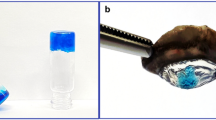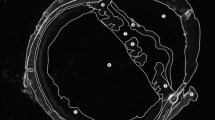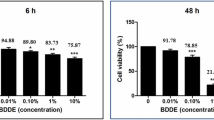Abstract
Eye-drop formulations should hold as high a concentration of soluble drug in contact with ocular epithelium for as long as possible. However, eye tears and frequent blinking limit drug retention on the ocular surface, and gelling drops typically form clumps that blur vision. Here, we describe a gelling hypotonic solution containing a low concentration of a thermosensitive triblock copolymer for extended ocular drug delivery. On topical application, the hypotonic formulation forms a highly uniform and clear thin layer that conforms to the ocular surface and resists clearance from blinking, increasing the intraocular absorption of hydrophilic and hydrophobic drugs and extending the drug–ocular-epithelium contact time with respect to conventional thermosensitive gelling formulations and commercial eye drops. We also show that the conformal gel layer allows for therapeutically relevant drug delivery to the posterior segment of the eyeball in pigs. Our findings highlight the importance of formulations that conform to the ocular surface before viscosity enhancement for increased and prolonged ocular surface contact and drug absorption.
This is a preview of subscription content, access via your institution
Access options
Access Nature and 54 other Nature Portfolio journals
Get Nature+, our best-value online-access subscription
$29.99 / 30 days
cancel any time
Subscribe to this journal
Receive 12 digital issues and online access to articles
$99.00 per year
only $8.25 per issue
Buy this article
- Purchase on Springer Link
- Instant access to full article PDF
Prices may be subject to local taxes which are calculated during checkout






Similar content being viewed by others
Data availability
The main data supporting the findings of this study are available within the paper and its Supplementary information. The associated raw data are too large to be readily shared publicly but are available from the corresponding author on reasonable request.
References
Urtti, A., Pipkin, J. D., Rork, G. & Repta, A. J. Controlled drug delivery devices for experimental ocular studies with timolol 1. In vitro release studies. Int. J. Pharm. 61, 235–240 (1990).
Hermann, M. M., Papaconstantinou, D., Muether, P. S., Georgopoulos, G. & Diestelhorst, M. Adherence with brimonidine in patients with glaucoma aware and not aware of electronic monitoring. Acta Ophthalmol. 89, E300–E305 (2011).
Agrawal, A. K., Das, M. & Jain, S. In situ gel systems as ‘smart’ carriers for sustained ocular drug delivery. Expert Opin. Drug Del. 9, 383–402 (2012).
Dumortier, G., Grossiord, J. L., Agnely, F. & Chaumeil, J. C. A review of poloxamer 407 pharmaceutical and pharmacological characteristics. Pharm. Res. 23, 2709–2728 (2006).
Rowe, R. C., Sheskey, P. J., Owen, S. C. & American Pharmacists Association. Handbook of Pharmaceutical Excipients 6th edn (Pharmaceutical Press, 2009).
Escobar-Chavez, J. J. et al. Applications of thermo-reversible pluronic F-127 gels in pharmaceutical formulations. J. Pharm. Pharm. Sci. 9, 339–358 (2006).
Schuster, B. S., Ensign, L. M., Allan, D. B., Suk, J. S. & Hanes, J. Particle tracking in drug and gene delivery research: state-of-the-art applications and methods. Adv. Drug Deliv. Rev. 91, 70–91 (2015).
Squires, T. M. & Mason, T. G. Fluid mechanics of microrheology. Annu. Rev. Fluid Mech. 42, 413–438 (2010).
Ensign, L. M., Schneider, C., Suk, J. S., Cone, R. & Hanes, J. Mucus penetrating nanoparticles: biophysical tool and method of drug and gene delivery. Adv. Mater. 24, 3887–3894 (2012).
Zignani, M., Tabatabay, C. & Gurny, R. Topical semi-solid drug delivery: kinetics and tolerance of ophthalmic hydrogels. Adv. Drug Deliv. Rev. 16, 51–60 (1995).
Cantor, L. B. Brimonidine in the treatment of glaucoma and ocular hypertension. Ther. Clin. Risk Manag. 2, 337–346 (2006).
McDougal, A. J. (ed.) Pharmacology/Toxicology NDA Review And Evaluation Simbrinza (NDA204251) (Food and Drug Administration Center for Drug Evaluation and Research, 2012).
Hackett, S. F. et al. Sustained delivery of acriflavine from the suprachoroidal space provides long term suppression of choroidal neovascularization. Biomaterials 243, 119935 (2020).
Tsujinaka, H. et al. Sustained treatment of retinal vascular diseases with self-aggregating sunitinib microparticles. Nat. Commun. 11, 694 (2020).
Fathalla, Z. M. A. et al. Poloxamer-based thermoresponsive ketorolac tromethamine in situ gel preparations: design, characterisation, toxicity and transcorneal permeation studies. Eur. J. Pharm. Biopharm. 114, 119–134 (2017).
Abdelkader, H., Ismail, S., Kamal, A. & Alany, R. G. Design and evaluation of controlled-release niosomes and discomes for naltrexone hydrochloride ocular delivery. J. Pharm. Sci. 100, 1833–1846 (2011).
Rodrigues, G. A. et al. Topical drug delivery to the posterior segment of the eye: addressing the challenge of preclinical to clinical translation. Pharm. Res. 35, 245 (2018).
Goodman, V. L. et al. Approval summary: sunitinib for the treatment of imatinib refractory or intolerant gastrointestinal stromal tumors and advanced renal cell carcinoma. Clin. Cancer Res. 13, 1367–1373 (2007).
Roskoski, R. Jr. Sunitinib: a VEGF and PDGF receptor protein kinase and angiogenesis inhibitor. Biochem. Biophys. Res. Commun. 356, 323–328 (2007).
Craig, J. P., Simmons, P. A., Patel, S. & Tomlinson, A. Refractive index and osmolality of human tears. Optom. Vis. Sci. 72, 718–724 (1995).
Gonzalez-Meijome, J. M. et al. Refractive index and equilibrium water content of conventional and silicone hydrogel contact lenses. Ophthalmic Physiol. Opt. 26, 57–64 (2006).
Patel, A., Cholkar, K., Agrahari, V. & Mitra, A. K. Ocular drug delivery systems: an overview. World J. Pharm. 2, 47–64 (2013).
Deokule, S., Sadiq, S. & Shah, S. Chronic open angle glaucoma: patient awareness of the nature of the disease, topical medication, compliance and the prevalence of systemic symptoms. Ophthal. Physiol. Opt. 24, 9–15 (2004).
Inoue, K. Managing adverse effects of glaucoma medications. Clin. Ophthalmol. 8, 903–913 (2014).
Schwartz, G. F. & Quigley, H. A. Adherence and persistence with glaucoma therapy. Surv. Ophthalmol. 53 (Suppl. 1), S57–S68 (2008).
Stewart, W. C., Chorak, R. P., Hunt, H. H. & Sethuraman, G. Factors associated with visual loss in patients with advanced glaucomatous changes in the optic nerve head. Am. J. Ophthalmol. 116, 176–181 (1993).
Shedden, A., Laurence, J., Tipping, R. & Timoptic, X. E. S. G. Efficacy and tolerability of timolol maleate ophthalmic gel-forming solution versus timolol ophthalmic solution in adults with open-angle glaucoma or ocular hypertension: a six-month, double-masked, multicenter study. Clin. Ther. 23, 440–450 (2001).
Walters, T. R. et al. Efficacy and tolerability of 0.5% timolol maleate ophthalmic gel-forming solution QD compared with 0.5% levobunolol hydrochloride BID in patients with open-angle glaucoma or ocular hypertension. Clin. Therapeutics 20, 1170–1178 (1998).
Lira, M., Pereira, C., Real Oliveira, M. E. & Castanheira, E. M. Importance of contact lens power and thickness in oxygen transmissibility. Cont. Lens Anterior Eye 38, 120–126 (2015).
Olsen, T. On the calculation of power from curvature of the cornea. Br. J. Ophthalmol. 70, 152–154 (1986).
Jager, R. D., Aiello, L. P., Patel, S. C. & Cunningham, E. T. Risks of intravitreous injection: a comprehensive review. Retina 24, 676–698 (2004).
Singer, M. A. et al. HORIZON: an open-label extension trial of ranibizumab for choroidal neovascularization secondary to age-related macular degeneration. Ophthalmology 119, 1175–1183 (2012).
Friedrich, S., Cheng, Y. L. & Saville, B. Drug distribution in the vitreous humor of the human eye: the effects of intravitreal injection position and volume. Curr. Eye Res. 16, 663–669 (1997).
Kaplan, H. J., Chiang, C. W., Chen, J. & Song, S. K. Vitreous volume of the mouse measured by quantitative high-resolution MRI. Invest. Ophthalmol. Vis. Sci. 51, 4414 (2010).
Doughty, M. J. & Zaman, M. L. Human corneal thickness and its impact on intraocular pressure measures: a review and meta-analysis approach. Surv. Ophthalmol. 44, 367–408 (2000).
Zhang, H. et al. The measurement of corneal thickness from center to limbus in vivo in C57BL/6 and BALB/c mice using two-photon imaging. Exp. Eye Res. 115, 255–262 (2013).
Park, H. et al. Assessment of axial length measurements in mouse eyes. Optom. Vis. Sci. 89, 296–303 (2012).
Bekerman, I., Gottlieb, P. & Vaiman, M. Variations in eyeball diameters of the healthy adults. J. Ophthalmol. 2014, 503645 (2014).
Iwase, T. et al. Topical pazopanib blocks VEGF-induced vascular leakage and neovascularization in the mouse retina but is ineffective in the rabbit. Invest. Ophthalmol. Vis. Sci. 54, 503–511 (2013).
Boettger, M. K., Klar, J., Richter, A. & von Degenfeld, G. Topically administered regorafenib eye drops inhibit grade IV lesions in the non-human primate laser CNV model. Invest. Ophthalmol. Vis. Sci. 56, 2294 (2015).
Joussen, A. M. et al. The developing regorafenib eye drops for neovascular age-related macular degeneration (DREAM) study: an open-label phase II trial. Brit J. Clin. Pharm. 85, 347–355 (2019).
Horita, S. et al. Species differences in ocular pharmacokinetics and pharmacological activities of regorafenib and pazopanib eye-drops among rats, rabbits and monkeys. Pharmacol. Res. Perspect. 7, e00545 (2019).
Loftsson, T., Hreinsdottir, D. & Stefansson, E. Cyclodextrin microparticles for drug delivery to the posterior segment of the eye: aqueous dexamethasone eye drops. J. Pharm. Pharmacol. 59, 629–635 (2007).
Ohira, A. et al. Topical dexamethasone γ-cyclodextrin nanoparticle eye drops increase visual acuity and decrease macular thickness in diabetic macular oedema. Acta Ophthalmol. 93, 610–615 (2015).
Gilger, B. C. Ocular Pharmacology and Toxicology (Humana Press, 2014).
Ruiz-Ederra, J. et al. The pig eye as a novel model of glaucoma. Exp. Eye Res. 81, 561–569 (2005).
Olsen, T. W., Aaberg, S. Y., Geroski, D. H. & Edelhauser, H. F. Human sclera: thickness and surface area. Am. J. Ophthalmol. 125, 237–241 (1998).
Vurgese, S., Panda-Jonas, S. & Jonas, J. B. Scleral thickness in human eyes. PLoS ONE 7, e29692 (2012).
Olsen, T. W., Sanderson, S., Feng, X. & Hubbard, W. C. Porcine sclera: thickness and surface area. Invest. Ophthalmol. Vis. Sci. 43, 2529–2532 (2002).
Struble, C., Howard, S. & Relph, J. Comparison of ocular tissue weights (volumes) and tissue collection techniques in commonly used preclinical animal species. Acta Opthalmol. 92, https://doi.org/10.1111/j.1755-3768.2014.S005.x (2014).
Rajapaksa, T. E. et al. Intranasal M cell uptake of nanoparticles is independently influenced by targeting ligands and buffer ionic strength. J. Biol. Chem. 285, 23739–23746 (2010).
Ensign, L. M., Hoen, T. E., Maisel, K., Cone, R. A. & Hanes, J. S. Enhanced vaginal drug delivery through the use of hypotonic formulations that induce fluid uptake. Biomaterials 34, 6922–6929 (2013).
Pihl, L., Wilander, E. & Nylander, O. Comparative study of the effect of luminal hypotonicity on mucosal permeability in rat upper gastrointestinal tract. Acta Physiol. 193, 67–78 (2008).
Noach, A. B. J. et al. Effect of anisotonic conditions on the transport of hydrophilic model compounds across monolayers of human colonic cell lines. J. Pharmacol. Exp. Ther. 270, 1373–1380 (1994).
Nance, E. A. et al. A dense poly(ethylene glycol) coating improves penetration of large polymeric nanoparticles within brain tissue. Sci. Transl. Med. 4, 149ra119 (2012).
Wilhelmus, K. R. The draize eye test. Surv. Ophthalmol. 45, 493–515 (2001).
Wolffsohn, J. S. et al. TFOS DEWS II diagnostic methodology report. Ocul. Surf. 15, 539–574 (2017).
Bron, A. J., Evans, V. E. & Smith, J. A. Grading of corneal and conjunctival staining in the context of other dry eye tests. Cornea 22, 640–650 (2003).
Acknowledgements
The authors thank D. Guyton for sharing his expertise in light refraction, F. Selaru and L. Li for assistance with the swine animal protocol, and the veterinary and husbandry staff for their assistance. This work was supported by the National Institutes of Health (NIH) (grant nos. R01EB016121, R01EY026578 and P30EY001765), the Robert H. Smith Family Foundation, Guerrieri Family Foundation, a Sybil B. Harrington Special Scholar Award and a departmental grant from Research to Prevent Blindness, the KKESH–WEI Collaborative Research Fund, and a Hartwell Foundation Postdoctoral Fellowship. Drug measurements were conducted by the Analytical Pharmacology Core of the Sidney Kimmel Comprehensive Cancer Center at Johns Hopkins. The work conducted by the Analytical Pharmacology Core was supported by the NIH grants P30CA006973, S10RR026824 and S10OD020091, as well as grant number UL1TR001079 and UL1TR003098 from the National Center for Advancing Translational Sciences, a component of the NIH, and the NIH Roadmap for Medical Research. This paper and its contents are solely the responsibility of the authors and do not necessarily represent the official view of the National Center for Advancing Translational Sciences or the NIH.
Author information
Authors and Affiliations
Contributions
Y.C.K., M.D.S., S.F.H., A.S.J., P.J.M., D.J.Z., P.A.C., J.H. and L.M.E. designed experiments. Y.C.K., M.S., S.H., H.T.H., R.L.e.S., A.D., H.H, B.-J.K., A.X., Y.K., L.O., N.M.A., A.H., P.H., C.E. and I.P. performed experiments and/or analysed experimental data. Y.C.K., M.S., S.H., B.-J.K., N.M.A., J.H. and L.M.E. wrote sections of the manuscript. All authors read and approved the final version of the manuscript.
Corresponding authors
Ethics declarations
Competing interests
Y.C.K., A.D., L.M.E. and J.H. are inventors on US patent nos. US10092509B2, US10646434B2 and US10485757B2; Australian patent no. AU2016211696B2; Canadian patent no. CA2974715C; and on 11 pending patent applications related to this technology. J.H. and L.E. are founders and have equity in NovusBio LLC. NovusBio LLC intends to develop products using the technology described in this manuscript. The terms of this arrangement are being managed by the Johns Hopkins University in accordance with its conflict of interest policies.
Additional information
Publisher’s note Springer Nature remains neutral with regard to jurisdictional claims in published maps and institutional affiliations.
Supplementary information
Supplementary Information
Supplementary methods, figures, tables, video caption and references.
Supplementary Video 1
Visualization of the behaviour of 18% iso compared with 12% hypo after administration to conscious rabbits.
Rights and permissions
About this article
Cite this article
Kim, Y.C., Shin, M.D., Hackett, S.F. et al. Gelling hypotonic polymer solution for extended topical drug delivery to the eye. Nat Biomed Eng 4, 1053–1062 (2020). https://doi.org/10.1038/s41551-020-00606-8
Received:
Accepted:
Published:
Issue Date:
DOI: https://doi.org/10.1038/s41551-020-00606-8
This article is cited by
-
Recent advances in ocular lubrication
Friction (2024)
-
Machine learning-driven multifunctional peptide engineering for sustained ocular drug delivery
Nature Communications (2023)
-
A hypotonic gel-forming eye drop provides enhanced intraocular delivery of a kinase inhibitor with melanin-binding properties for sustained protection of retinal ganglion cells
Drug Delivery and Translational Research (2022)
-
Celastrol-based nanomedicine promotes corneal allograft survival
Journal of Nanobiotechnology (2021)
-
A topical gel for extended ocular drug release
Nature Biomedical Engineering (2020)



